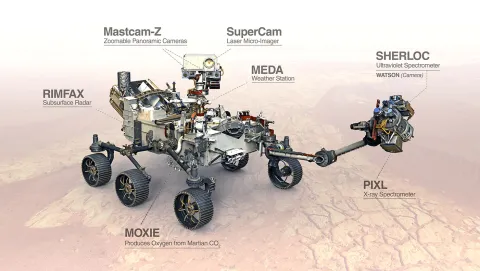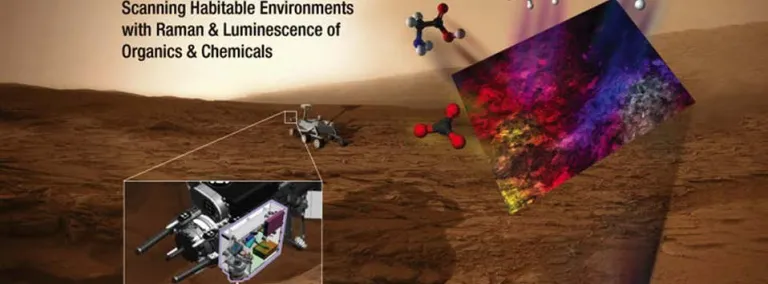SHERLOC goes to Mars
The mystery of ancient life on Mars calls for inter-planetary detective work
Deep underground, where oxygen is scarce, and sunlight never gleams, life somehow thrives. At Sanford Underground Research Facility (Sanford Lab), researchers study subterranean microbes to better understand how life forms could survive in other extreme places—places like Mars.
On July 30, NASA expects to launch its fourth rover toward Mars. Once it escapes Earth’s gravity, the Perseverance Rover will stream outward, intercepting Mars’ orbit on February 18, 2021. For one Mars year (687 Earth days), it will scour the surface for signs of ancient life. On board, Perseverance will carry a detective instrument called SHERLOC (Scanning Habitable Environments with Raman & Luminescence for Organics & Chemicals), a concept that was tested on the 4850 Level of Sanford Lab.
Searching for signs of bygone life
Although there is no evidence of extant life on the surface of Mars, researchers believe the planet—made of the same primordial substances as Earth—once boasted all the conditions necessary for living organisms to form.
“Three and a half billion years ago, Mars seems to have had everything the Earth did when life started on Earth,” said Luther Beegle, principal investigator of SHERLOC with NASA's Jet Propulsion Laboratory. “So, the question is: Did life start there? And if not, why not?”
To answer this question, researchers look to the timeline encrypted in Mars’ rocks.
The Perseverance Rover will land in a massive depression called Jezero Crater. Long ago, a lake the size of Lake Tahoe lapped against Martian shores in the midst of the crater. As Mars’ climate changed, the lake dried up, leaving sand and mud deposits to dry and crackle in the sun. Those deposits are now a rich source of information about what life—if any—once bloomed in the lake.
Perseverance will explore this lakebed and the fan-shaped delta that fed it, seeking signs of ancient life and collecting rock and soil samples for possible return to Earth.
This video provides an overview of the Perseverance Rover's mission. Video courtesy NASA Jet Propulsion Laboratory
Dusting for fingerprints
Mounted on Perseverance’s robotic arm, SHERLOC uses spectrometers, a laser and a camera to search for organics and minerals that may be signs of past microbial life.

The Perseverance Rover will carry seven state-of-the-art tools for acquiring information about Martian geology, atmosphere, environmental conditions, and potential biosignatures. Image courtesy NASA.
SHERLOC uses Raman spectroscopy, a special property of light, to identify the composition of samples it encounters along its journey. When a beam of monochromatic light—light traveling uniformly through space—is reflected off a material, some of the light is scattered, breaking from the otherwise unvarying wavelength and amplitude of the beam. Every organic molecule or compound has its own unique scattering signature, or fingerprint.
SHERLOC will aim a laser on a sample to observe how the light reflects and scatters. Then, SHERLOC will deduce the composition of each sample—all without touching or crushing the rock.
This is the first time Raman spectroscopy will be deployed on Mars, but SHERLOC won’t brave the red planet alone. WATSON (Wide Angle Topographic Sensor for Operations and eNgineering), a camera capable of microscopic imaging, will accompany SHERLOC.
“WATSON puts everything in perspective,” Beegle said. “We overlay the chemistry, mineralogy and organic composition from SHERLOC on WATSON’s color image to create a chemical map.”
Not only can it tell us what minerals there are, but it can tell us how they are distributed through the rock. With these clues, researchers can decide which samples warrant a trip back to Earth.
“If we see certain combinations of minerals and see that they are clumped together—that is something really exciting—we should bring that back to Earth and look at it in our laboratories,” Beegle said.
Testing the technology
In 2014, a NASA Astrobiology Institute Research grant was awarded to the University of Southern California to deploy the SHERLOC detection technique underground at Sanford Lab.
“It’s one thing to use a scientific concept in a laboratory, but it's a whole different set of experiences in the field,” Beegle said. “The tests at Sanford lab provided valuable information on how to actually operate and how to refine the technique.”
The team studied core samples taken from the 4850 Level for the Deep Underground Neutrino Experiment, or DUNE. By testing the concept at SURF, researchers could both perfect SHERLOC’s technology and learn more about the extremophiles underground.
"The NASA Astrobiology Institute embodies all of the main Sanford Lab research disciplines in one collaboration: biology, geology, engineering and physics. Not since an early gravity-wave experiment has one group taken advantage of so much of the our real estate breadth, with activities on multiple underground levels as well as work at the surface drill core archive," said Jaret Heise, science director at Sanford Lab. "It’s exciting to think that the electronic biology and geology 'scientist' on the upcoming mission to Mars was trained and tested at Sanford Lab."

The SHERLOC detection technique was installed at the NASA Astrobiology Institute's worksite on the 4850 Level of Sanford Lab in 2014. Photo by Greg Wanger
“Sanford Lab is an ideal place for this research because it’s a science facility,” said Greg Wanger, who was an assistant professor at the University of Southern California at the time of the tests. Wanger said the underground at Sanford Lab has “well-characterized geology and access to several levels, allowing 3-D windows into the subsurface.”
Teams also tested the SHERLOC concept in other extreme environments, including the floor of the Atlantic Ocean, Greenland, the Mojave Desert and deep underground in Borrego Springs, California.
Space exploration during COVID-19
To prepare for this mission, researchers tested SHERLOC’s technology in unique locations. But when the Perseverance Rover launches days from now, many researchers will be watching from home, due to COVID-19 work-from-home regulations.
“As a species, we've always wanted to be explorers. We've always wanted to see what is over that mountain, on the other side of the lake—always wanted to go to the other side of the sea and explore,” said Beegle. “I don't know what our own world will look like when Perseverance lands in February, but it's a fascinating thought—that we could be exploring Mars from our living rooms.”
Watch the launch
The Perseverance Rover launch is weather-dependent. The first launch opportunity begins at 4:50 a.m. PDT/ 7:50 a.m. EDT on July 30. The launch period is approximately three weeks, from July 30 to August 15. The duration of the daily launch window varies from day to day. The launch windows will last approximately two hours, with a unique launch opportunity every five minutes.
Visit NASA's website to learn how to watch the launch online.
